| |
|
Selection of Jambiyas
The Blade is Always Curved & Double-edged w/Median Ridge |
Persian Jambiya
Green Jade Hilt |
Khanjar from Lahore
18th Century |
|
Selection of Near Eastern Daggers (Late 18th/Early
19th Centuries)
From Left - Ear Dagger (Turkey) - 2 Pesh Kabz - Jambiya
(Egyptian) - Kard (Persian) |
Twin Bladed Katar
19th Century |
|
|
Assortment of Persian Blades |
|
Ivory Hilted Dagger w/Scabbard (19th Century)
Scabbard - Lacquered Wood, Mounted in Silver Set
Imbedded Semi-precious Stones |
Indo-Persian Dagger (18th Century)
Jade Hilt w/Turquoise Set Scabbard
Jade Hilt is Moghul Period (1700) |
2 Persian Daggers
(19th Century)
Ivory Hilt on Right Blade |
|
|
Mughal Court Daggers . . . circa 17th
Century
Steel, Jade, Amber, Rubies, Emeralds and Gold
Sheaths of Velvet |
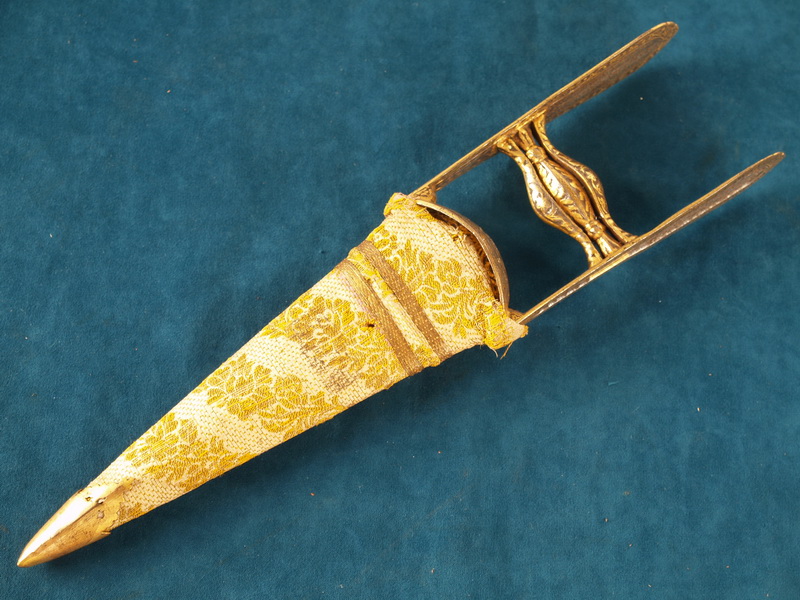 |
 |
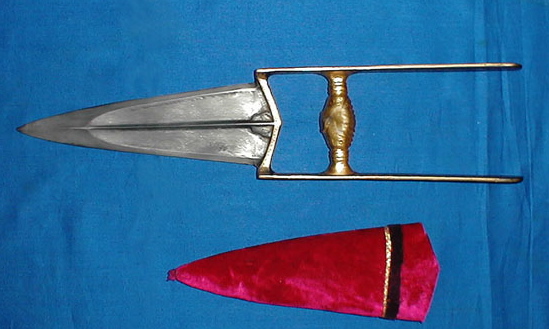 |
The
Katar
is the oldest and most characteristic of
the Indian knife weapons
Historians state that the
Katar was the first such dagger knife invented throughout all of
Indo-Persia. It is an Indian thrusting dagger, with armor piercing
qualities. The
Katar is a purely Hindu weapon and is never found outside
of India. Often used by the Maharajas when hunting for tigers. The peculiarity lies in the
handle which is made up of two parallel bars connected by two or more
cross pieces, one of which is at the end of the side bars and is
fastened to the blade. The remainder forms the handle which is at right
angle to the blade. The blades are always double-edged and are generally
straight, but occasionally curved, and with lengths from a few inches to about 3 feet.
Katars
are often thickened at the point and with a strong central rib to
strengthen them, for punching holes in mail armor, and are often forged
in one piece with the hilt. Because of its design, the full power of the
thrust went straight to the point. The
Katar is wrapped to the hand to optimize
the grip. Many
Katars have guards for the back of the hand made with
solid plates but many are elaborately pierced. Among the Mahrattas the
gauntlet sword, called Pata, was evolved from the Katar. |
| The Katar blades are sometimes forked at the point, and Katars
with two, and even three blades occur. The Indian armorer occasionally made
Katars
that were hollow and
served as a sheath for smaller ones: or with three blades that folded
together, appearing to be one, until the handle bars were pressed
together, when they opened out (See Below). There is even a
Katar
displayed at the City Palace Museum in Jaipur, with two single-shot
pistols built into either side of the weapon. This is an innovative
design, as it enables the user to immobilize at least two opponents even
before having to use the blade. |
|
"Peacock Hilt" Maharaja Katar Dagger |
Indian Katar (19th Century) - Wootz Steel
w/Scabbard |
|
African Knives and Daggers |
The forms of knives and daggers found in Africa are almost
infinitely diverse; given the size of the continent, the tribal nature
of the people, and the pervasive influences from the ancient Egyptians,
Romans and other invader/trader nations.
Technologically, the workmanship on African weapons cannot compare with
that of some other continents, but the artistic style with which the
African blade smiths designed their weapons is unsurpassed. The cultural
mythology often infused into the blades symbols, along with the abstract
nature of African art, is expressive of a vitality evident in the tribal
warriors of old. |
|
Yakoma or
Ngbandi Knife - Mid 19th Century |
"Tribal Knives" of the Yakoma and Ngbandi are similar and
difficult to tell apart. In addition to their formal, and primary
martial function, that were also used as currency, in particular to pay
a "Bride Price".
Zaire - This blade has some nicely incised decoration; the hilt
is bound with copper, and it is made with a leather covered pommel.
Length = 19 inches. |
|
Mangbetu Knife - Mid 19th Century |
Mangbetu of Northeastern Zaire - Called this weapon a "Trumbash".
Its very particular shape is said to derive from ancient Egypt. An
Egyptian carving of Rameses III (King of Egypt - 1184 to 1156 BC) shows
him using a very similar "Sickle Sword", when in the act of executing
his enemies.
Sickle Shaped Blade - Sharpened on both ends, and wooden hilt
with cylindrical pommel. Length = 9 inches. |
|
Konda Shortsword - Mid 19th Century |
Produced by the Konda of Haute-Zaire - Although its general
shape commends it to close fighting, there is no doubt that in peaceful
times it would have doubled as a particularly useful general purpose
knife.
Disc Pommel is "Sun Hat" Shape - The wooden hilt and sheath are
studded with brass nail heads forming a dense covering. Length = 12 1/4
inches. |
|
Ngala Knife - Late 19th Century |
Ngala Swords from Zaire - With their unique form of sickle
shaped blade, they were sometimes used for a particularly gruesome form
of execution. The victim was secured to the ground with his head tied to
a supple tree bent over for the purpose. At the moment of decapitation
the head was catapulted into the distance.
Sickle Shaped Blade - Hilt bound with copper or brass tape.
Length = 17 inches. |
|
Sudanese Dagger - Late 19th Century |
Dagger From Sudan - Typical of daggers carried by followers
of the Madhi during the last quarter of the 19th century. It was
intended primarily for stabbing, and the blade swells out towards the
tip, which is slightly thickened in section. The blade is sharp on both
edges and is contained in a leather sheath lined with cotton.
The handle is made from lightweight, dense boxwood type timber. Length =
10 1/2 inches |
|
Sudanese Double Dagger - Late 19th
Century |
Double Dagger from Sudan - It is associated with followers of
the Mahdi during the 1880s.
Blades are Etched with Inscriptions in Thuluth Script - Thuluth
derives from a script used by the Mamluks for monumental inscriptions.
The wooden grip and sheaths are covered with multicolored glass
beadwork. Length = 22 inches. |
|
Hadendoa Dagger - Late 19th Century |
Northeast African - Hadendoa are a Nilotic people from Sudan,
Egypt and Eritrea. Their unique style of dagger has an H-shaped Ebony
hilt, sometimes with silver wire binding and fittings. It was carried in
a leather sheath.
Extensively used when fighting against the British in support of the
Madhi in Sudan at the end of the 19th century. It was also used to
"Hamstring" British horses.
Ebony hilt carved with flutes. The blade design is of shallow diamond
section. Length = 7.7 inches. |
|
Sudanese Throwing (Ceremonial )
Knife - Circa 1900 |
| Possessing Multiple Projecting Blades - Sometimes stamped
with geometric ornamentation, they have grips often bound with leather
over cotton cloth, as in above example. |
|
Nubian Arm Dagger - Circa 1900 |
Nubia is a Region of the Sudan - It is close to the Nile
River. These daggers are worn in leather sheaths which have woven
leather straps to bind them to the wearer's arm.
Ebony Hilt with circular pommel. Often these dagger hilts have a
pommel made of Ivory. The flat, faceted blade is sometimes inscribed.
Length = 10.8 inches.b |
|
Central African Arm Knife - Early
20th Century |
Type of "Arm Dagger" - Commonly encountered all over Central
and North Africa, from Nigeria to Sudan, and from the Sahara
Desert to Cameroon. They are distinguished by the woven leather bindings
to the hilt, and by the protruding flattened iron pommel. They are still
being made by a large variety of tribes and craftsmen.
African Arm Knife - Iron pommel integral with the blade. Woven
leather wrap to the hilt. Very shallow 'Diamond Section' blade. |
|
Somali 'Billa' Knife - Circa 1900 |
Somali Knife - Produced by Arab cutlers who imported the
skills of silversmithing from Oman. Arab interaction with Africa's east
coast occurred through trade. Zanzibar was ruled by Oman during the 18th
and 19th centuries. Only the finest of these knives have hilts of
'Ivory and Silver'. All others are made from 'Horn or Wood'.
Ivory Hilt and Silver Pommel - With a thin, broad blade. Length =
17.1 inches. |
|
Moroccan Jambiya or Koumiya - Early
20th Century |
Jambiya Daggers - Among the most numerous ever to have been
produced in Africa. The design always conforms very closely. However,
the grips can be made from 'Wood, Bone or Ivory', while the
mounts are of 'Brass, Silver, even Gold'. The blades are mostly
plain or undecorated.
Moroccan Jambiya - Double edged. It has a wooden grip and metal
pommel. Length = 12.2 inches.
There is a Long History of the Jambiya. Evidence of the oldest
Jambiyas show they were worn in Sheban times, in the Himiarite Kingdom;
a statue of the Sheban King dating from 500 B.C. includes a Jambiya.
Today, the Jambiya is the main customary accessory to the clothing worn
by traditionally garbed Arab men. A manís Jambiya is carefully
protected and worn for life; almost an indispensable part of their
personalities. It is said that no man is complete without his Jambiya. |
|
 |
|
 |
|
Japanese Blades were all made by the same methods
and are the same shapes and sections for Swords and Knives
Their difference being solely in the lengths.
The lengths of the different blade types are approximately given below. |
|
Jin Tachi
Katana and Tachi
Chisa Katana
Wakizashi
Tanto and Aikuchi
Yoroi and Toshi
Kwaiken
|
|
- 33 inches and over
- 24 to 30 inches
- 18 to 24 inches
- 16 to 20 inches
- 11 to 16 inches
- 9 to 22 inches
- 3 to 6 inches |
|
From the Mid-19th century on, although some very fine
blades were made at this time, nevertheless the majority were intended
for foreign purchase. The European "aesthetic movement" of the later
19th century was influenced by Japanese art. Both Europe and the United
States evinced a seemingly boundless appetite for Japanese art and
artifacts. |
|
Japanese Dagger - Early 19th Century |
| Length 16.9 inches - A blade which has been formed with no
ridges on either side has a shape called "Hira Zukuri". This individual
example has been cut with a pair of short shallow grooves called "Hi".
The mounting is tasteful and of good quality. It has a 'Ray Skin'
covered grip. The sheath is coated with lacquer, a durable finish. The
sheath is made from the ground-up wing cases of various beetles. |
|
Japanese Aikuchi - Late Edo . . .
circa 1860 |
| Length 13.1 inches - Example of Japanese Aikuchi. This
particular dagger was made in the second half of the 19th century. The
mounts (Koshirae) are made from brass. The hilt (Tsuka) and sheath (Saya)
are beautifully lacquered. A silk strap (Sageo) is used to tie the
sheath to a belt. |
|
Japanese Tanto - Late Edo . . .
circa 1860 |
| Length 17 inches - The hilt of this Tanto is bound with silk
tape, although sometimes string, leather or even baleen was used. The
grip is covered with 'Ray Skin (Same)' and fitted with two ornaments (Menuki)
before being bound. The Memuki provide a more secure grip. The sheath is
fitted with an end mount (Kojiri) intended to protect the sheath, but in
practice it is merely a vehicle for further ornamentation. |
|
Japanese Tanto - Meiji . . . circa
1870 |
| Length 12.6 inches - This blade is contained within a plain
wooden hilt and sheath, usually made of Magnolia wood. It is entirely
devoid of any fittings. The Magnolia is intended to protect the blade
and to provide a suitable method of storage. This blade has a carved
decoration called "Horimono". |
|
Japanese Ken - Late Edo . . . circa 1850 |
| Length 12.1 inches - This straight double-edged dagger is
called a Ken. It is the weapon carried by some Buddhist Divinities. It
originated in China from whence the sword (and Buddhism) was introduced
into Japan during the 7th and 8th centuries. Many such Ken were made for
Temple presentations. Fine grained fish skin sheath w/companion knife (Kodzuka)
and fine grained fish skin covered hilt. Metal sleeve (Habaki) engraved
with lines to provide grip to inside of sheath. |
Throughout History - 'German Warriors' have attached
deep significance and honored tradition to the bearing of swords and
daggers. The Teutons placed a sword in the cradle of newborn males to
give them courage, and when brave warriors died, their swords were
placed in their graves with them.
With the Rise of the Third Reich - Much old world tradition
associated with edged weapons was revived. Like their Teutonic
forebears, Hitler's elite swore their allegiance while holding one hand
on the blade of a weapon. |
|
SA (Sturmabteilung) Dagger
Brown Hilt & Scabbard |
NSKK (Kraftkorps)
Brown Hilt & Black Scabbard |
SS (Shutzstaffel) Dagger
Black Hilt & Scabbard |
NPEA (Politische)
Similar SA w/Different Motto |
|
Storm Troop
(Sturm Abteilung - SA) |
|
SA Dagger Motto - "Alles Fur
Deutschland"
(All for Germany) |
First Paramilitary Organization of the Nazi Party - The SA
was founded on November 4th, 1921, at a beer hall rally in Munich. Many
of its leaders as well as subordinates were of questionable character
and a type that took great pleasure in participating in brawls and other
rowdy activities.
The "Storm Troopers" - Were initially organized for the purpose
of serving as a protective force for Nazi Party meetings, but they soon
developed into a vicious, militarized, terroristic organization. |
|
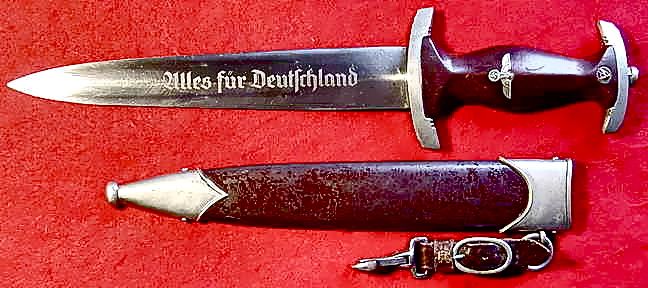 |
This Authentic Dagger - Has all nickel fittings with the
cross guard. The extremely fine wood handle has some surface dings but
no cracks or chips and fits tightly to the cross guard and pommel.
The Dagger Blade - Shows some of the original cross-graining and
has a nice clear acid-etched "Alles fur Deutschland" motto. The
blade has been re-tipped and shortened by about 1/4".
The Anodized Metal Scabbard - Retains all four original fitting
screws and almost all of its original brown finish with some original
clear lacquer protective finish still present. |
|
Nazi SA Dagger (Opposite View) |
|
Elite Guard
(Schutzstaffel - SS) |
|
SS Dagger Motto - "Meine Ehre HeiBt
Treue"
(My Honor is Loyalty) |
|
The SS was the most Feared, Despised
and Infamous
Of all the Organizations of the Entire Nazi Regime |
|
Nazi SS Dagger . . . circa 1933 Germany |
Originally - The SS was a small subunit formed in 1925 within
the SA to serve as Hitler's bodyguard, and its members were required to
swear a special oath of loyalty to Hitler personally. When Heinrich
Himmler took command of the SS in 1929, it was composed of only 280
members. The SS gained control of the national police forces and
expanded into a massive organization that soon dominated all of Germany.
There were two distinct branches of the SS:
General SS (Allgemeine SS) - These members wore the
dreaded 'Black Uniforms'.
Military SS (Waffen SS) - Organized into infantry and 'Armored
Combat Units'. |
|
German Luftwaffe (Air Force) |
|
Nazi Luftwaffe Officers Dress Dagger |
Near Excellent - Ivory-colored celluloid grip features tight
twisted double brass wire grip wrap. The near excellent pebbled scabbard
has a nice age patina to the finish and retains both original throat
screws.
This Dagger - Comes with deluxe hangers, plus with all spring
clips functioning. Also has an extremely fine aluminum portapee. |
|
Nazi Luftwaffe Officers Dress Dagger (Second Model) |
| Hermann Goering - Was a German political figure, military
leader, Gestapo founder, and leading member of the Nazi Party. A veteran
World War I 'Fighter Pilot Ace', he was a recipient of the
coveted "Blue Max" medal. Goering was appointed
"Commander-in-chief of the Luftwaffe (Air Force)" in 1935, a
position he held until the final days of World War II. Of all the high
ranking Nazi leaders, Hermann Goering was the most ardent enthusiast of
edged weapons. It is indeed rare to encounter a photograph of Goering
without an edged weapon of some type. |
|
Hermann Goering - Wearing Hunting Dagger (Shown
Above) |
This Dagger - Was surrendered by Goering on May 9th, 1945, to
Colonel W. W. Quinn, G2, Seventh U. S. Army. At the same time Goering
surrendered his Reichsmarshal's Baton. It was later donated by Colonel
Quinn to the West Point Museum.
This Rare Piece - Has a scabbard of red leather with bronze sides
and fittings. The overall length is 12 inches, and its two edged steel
blade is 7 1/2 inches long. The hilt is bronze and appears to have had a
silver gilt plating. The blade has a gold swastika etched on one side
below the hilt, and a runic inscription on the quill on on the same
side.
Translated Inscription Reads: "A Knife from Eric to Hermann"
It was presented to Goering by the Swedish Count Eric von Rosen,
Goering's brother-in-law by his first wife.
The fact the Goering was wearing this particular piece at the time of
his capture, as well as the existence of many photos showing him wearing
the same dagger, indicates that this was one of his favorite pieces. |
|
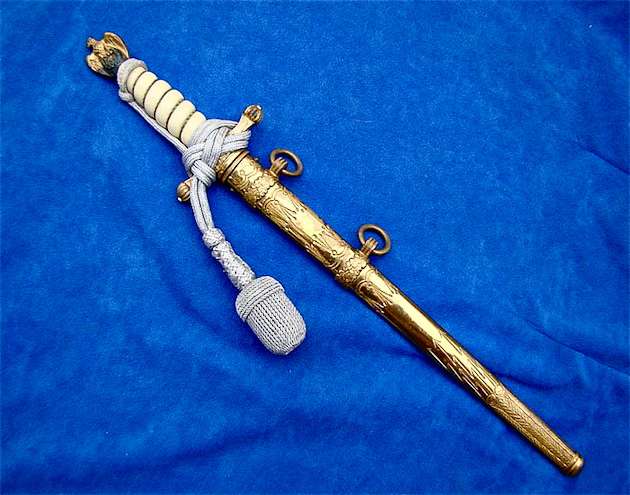 |
|
Nazi Naval Officers Dagger - Second Model |
|
|
Nazi Diplomatic Dagger |
Government Official Dagger |
|
|
Extremely Rare Prototype SS Dagger
(above) |
|
Proposed Design to Replace the SS Model of 1936 |
|
Peter Daniel Krebs Firm . . . circa
1940
Only this one Dagger was ever Produced |
| Note: It should be pointed out that Solingen blades were
virtually harvested as souvenirs by the Allied Forces, and most of
Solingen's rarest museum pieces and prototypes have slipped from
history's view into the attics and storerooms of World War II victorious
veterans, and then on to their family lineage as heirlooms. From these
have often come excellent pieces at auctions. |
|
12 Nazi
Prototype Dagger Designs - 1940 (below) |
|
Daggers for Adoption by the Various Nazi Party &
Military Organizations |
|
Daggers were Never put into
Production |
|
Trench Knifes - Germany WWII (Typical Examples) |
|
Advertisement Illustration - Original Color Plate
Krebs Firm . . . circa 1937
RAD Officer's Dagger |
|
Bowie Knife
Used in Attempted Assassination of John Brown |
|
This Knife is a 'Rare Treasure' from
a 'Period in American History' |
|
John Brown |
John Brown - Ascending Scaffold |
| John Brown - Was a radical 'Abolitionist' well-known
for his belief that armed insurrection was the only way to rid the
United States of slavery. He was eventually tried and hanged for his
actions against the South. |
|
"Last Moments of John Brown" Painting by Thomas
Hovenden |
|
This Knife - Is a 'Remarkable
Artifact'
From one of the 'Bloodiest Periods in American History' |
|
Bowie Knife with a 'Contemporary
Engraved Inscription'
Claiming it was "Taken by John Brown from an Attempted Assassin" |
| Coffin Handle Bowie Knife - Signed by maker Joseph Hawksley.
Overall length 14 1/4 in. (330 mm), length of steel spear-point blade 9
5/8 in. (245 mm), and a nickel grip inlaid with mother of pearl.
Accompanied by original brass-tipped gilt leather sheath; worn. |
|
King Tut's Blade is Made of
Meteorite Iron |
|
King Tut was Buried with a Dagger -
Made of an Iron - That 'Literally Came from Space' |
Using Non-invasive - Portable X-ray fluorescence
spectrometry, a team of researchers confirmed that the iron of the
dagger, placed on the right thigh of King Tut's mummified body, a has
'Meteoric Origin'.
The Weapon - On display at the Egyptian Museum in Cairo, was
described in 1925 by Howard Carter, who three years before had
discovered the treasure-packed tomb, as "a highly ornamented gold dagger
with crystal knob". |
|
Howard Carter - Opens the Coffin of King Tut |
Made From - Non-rusted, homogeneous metal, the finely
manufactured blade features a decorated gold handle. It is completed by
a gold sheath garnished with a floral lily motif on one side and with a
feathers pattern on the other side, terminating with a jackal's head.
Meteoric Iron - Clearly indicated by the presence of high
percentages of nickel.
Iron Meteorites - Are mostly made of iron and nickel, with minor
quantities of cobalt, phosphorus , sulfur and carbon. |
Artifacts - Produced with iron ore quarrying display 4
percent of nickel at most, the iron blade of King Tut's dagger was found
to contain nearly 11 percent of nickel.
Further confirmation of the blade's meteoric origin came from cobalt
traces.
Nickel and Cobalt Ratio - In the dagger blade is consistent with
that of iron meteorites that have preserved the primitive chondritic
ratio during planetary differentiation in the early solar system. |
|
Possible Source of the Iron Blade |
Considering all Meteorites - Found within an area of 2,000 km
in radius centered in the Red Sea, ended up with 20 iron meteorites.
Only one, named Kharga, turned out to have nickel and cobalt contents
which are possibly consistent with the composition of the blade.
The Meteorite Fragment - was found in 2000 on a limestone plateau
at Mersa Matruh, a seaport some 150 miles west of Alexandria.
Ancient Egyptians - Attributed great value to meteoritic iron for
the production of precious objects, perceiving chunks of iron falling
from the sky as a divine gift or a 'Piece of Heaven'. |
|
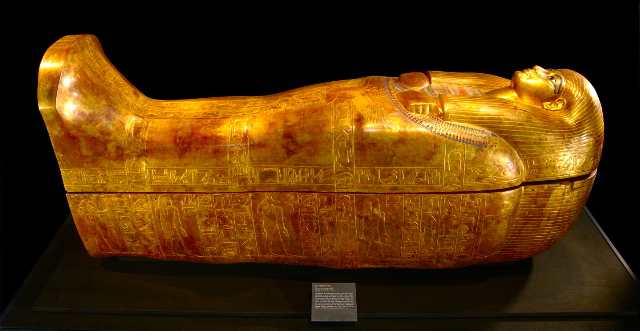 |
High Quality - Of King Tut's dagger blade shows that iron
smithing was successful already in the 14th century B.C.
The Dagger Blade - Is not the only 'Celestial Object'
found in the boy king's tomb. His pectoral, or necklace, features an
amulet scarab which is not "greenish-yellow chalcedony," as Carter had
noted, but Libyan Desert Silica Glass'.
The Glass - Was produced by the impact on the sand of a meteorite
or comet. Such natural glass exists only in the remote and inhospitable
Great Sand Sea of Egypt ó the Western Desert. In order to produce
the scarab, the ancient Egyptians would have had to trek across 500
desert miles. |
|
Traditionally - The Mission of Ground Troops is to
"Close with the Enemy and Destroy Them" |
Throughout History - Edged weapons have been a principle tool
for accomplishing this mission. With the advent of muskets and rifles in
warfare, soldiers quickly discovered the advantage of attaching an edged
weapon, a bayonet, to these firearms.
Hand-to-hand Close Combat - The cold steel at close quarters of
the bayonet or knife is, as it has always been, a formidable weapon.
Little change has been made in the design of bayonets throughout the
history of their deployment.
Bayonets Fall in 2 General Categories - Those produced for field
and combat, and those designed solely for traditional wear with dress
uniforms, or on parades, and at ceremonies. |
|
Top - American M1917 Bayonet for the M1917 30-in
Enfield Rifle
French Lebel Pattern 1886 Bayonet w/Downcurved Quillon
British Pritchard Greener Bayonet patented in 1916 - Designed for Webley
Mark VI Revolver
Pattern 1891 Russian Socket Bayonet w/Cruciform Blade for the Moisin
Nagant Rifle
Bottom - Belgium Mauser Bayonet Pattern 1889 |
|
Three Variations - WWII German Wehrmacht Dress or
Parade Bayonets (Chrome Plated) |
|
WWII German Presentation Honor Bayonet
Outstanding Military Skill
Usually Awarded with an Inscribed Blade |
|
December 2013
Pictures from the exhibition of bladed weapons that is being held in
Moscow.
Where one can buy the best products from the famous smiths of Russia,
Japan, USA, France etc. |
|
 |
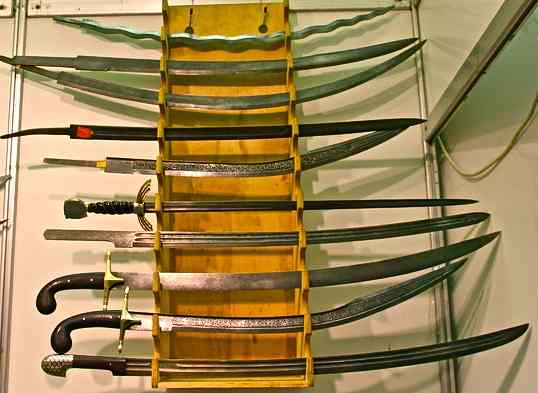 |
|
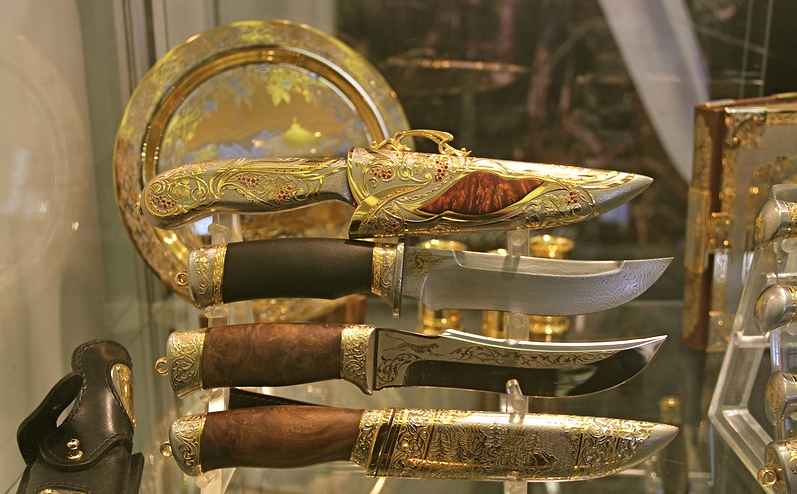 |
|
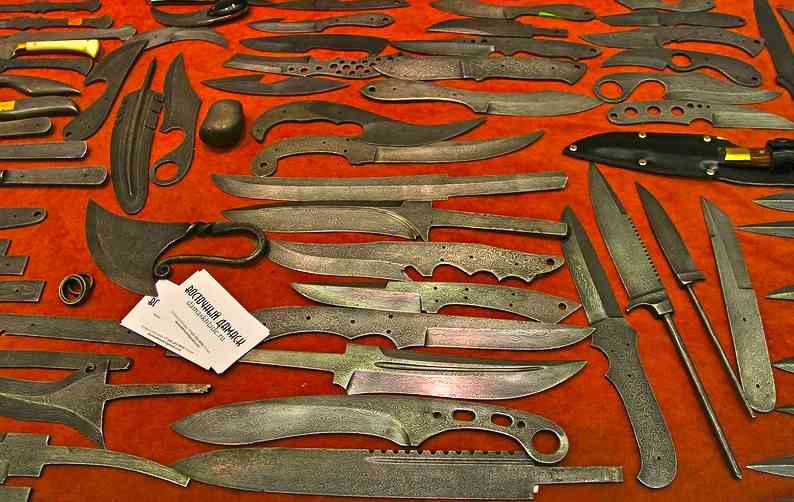 |
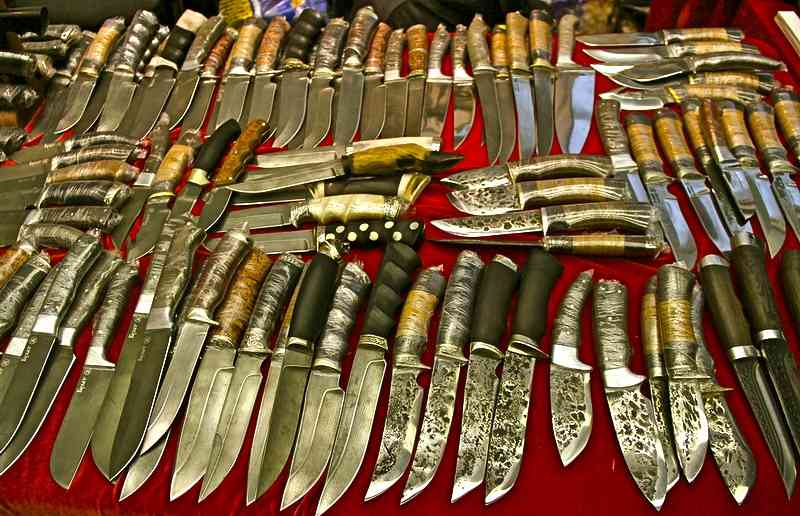 |
|
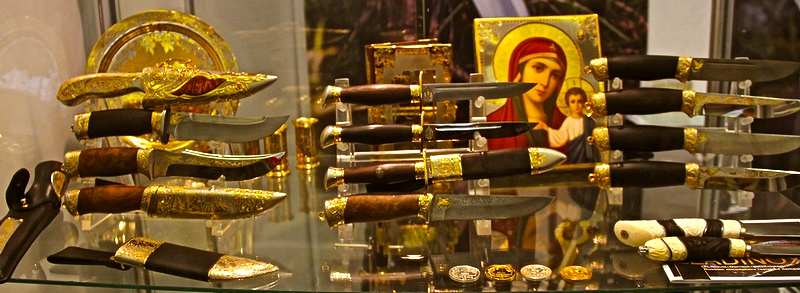 |
|
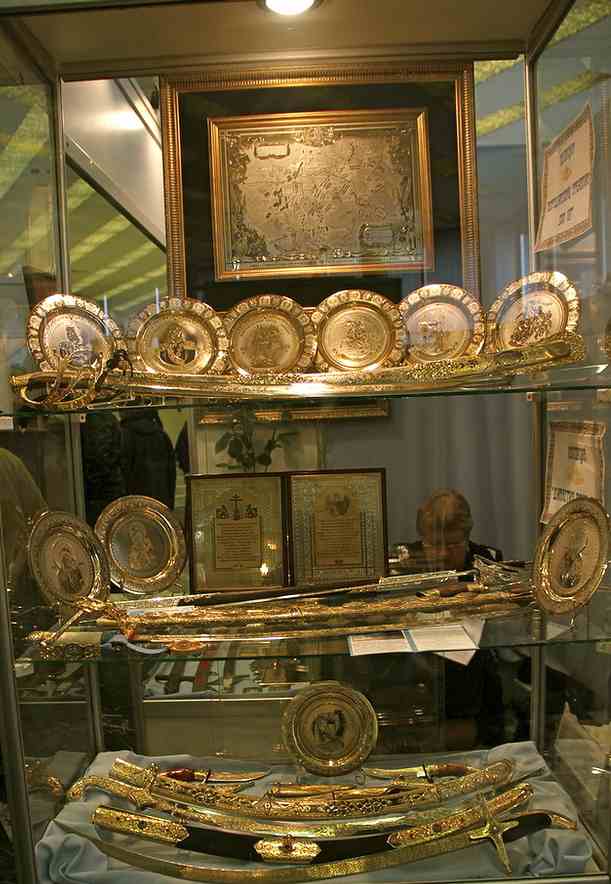 |
|
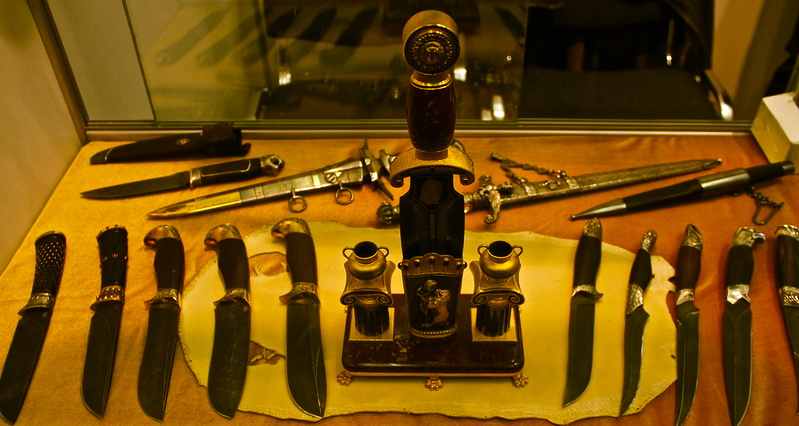 |
|
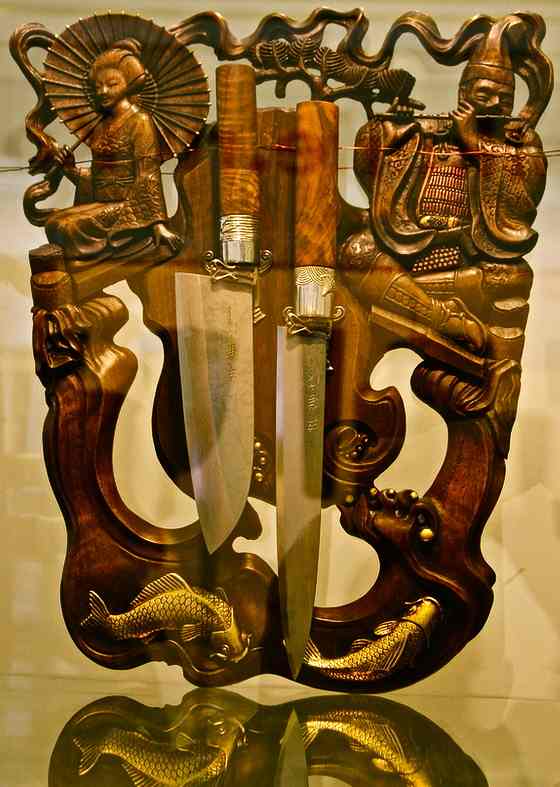 |
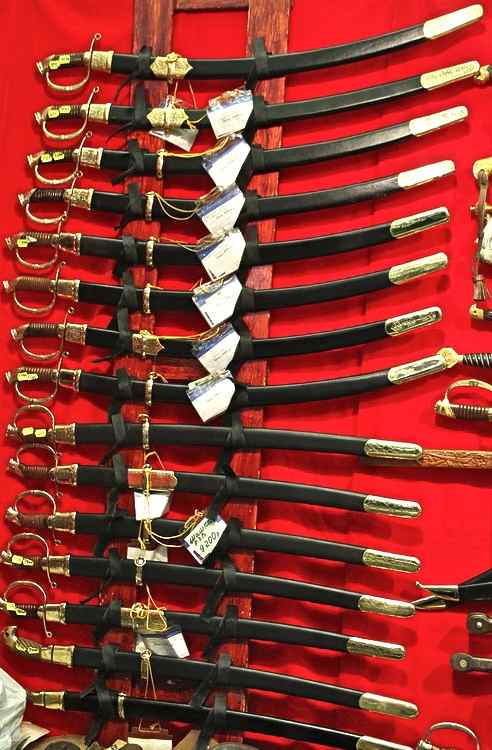 |
|
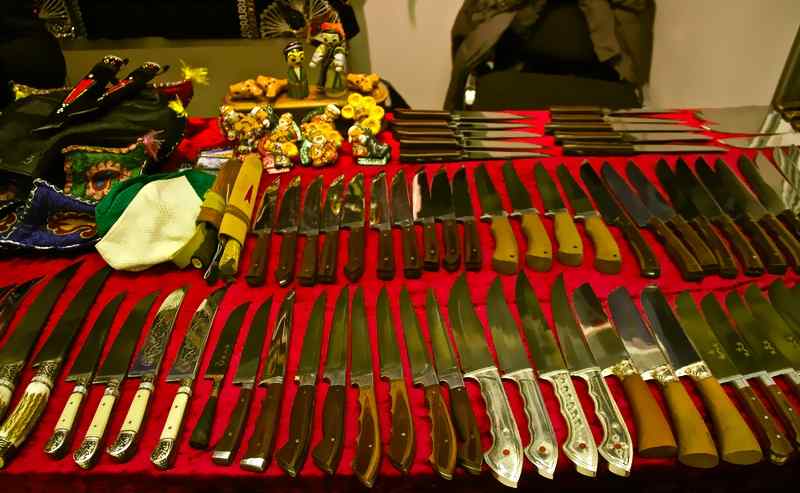 |
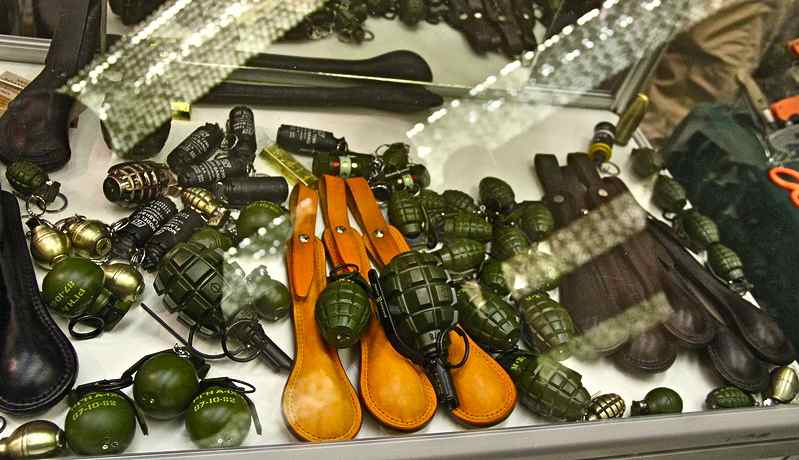 |
|
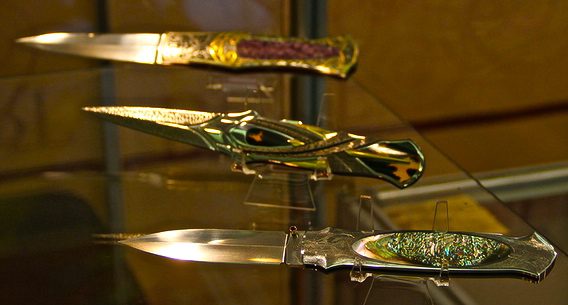 |
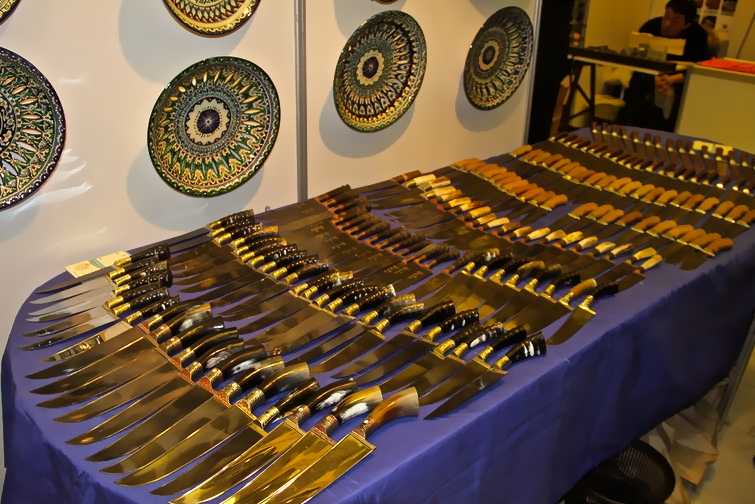 |
|
 |
|

|
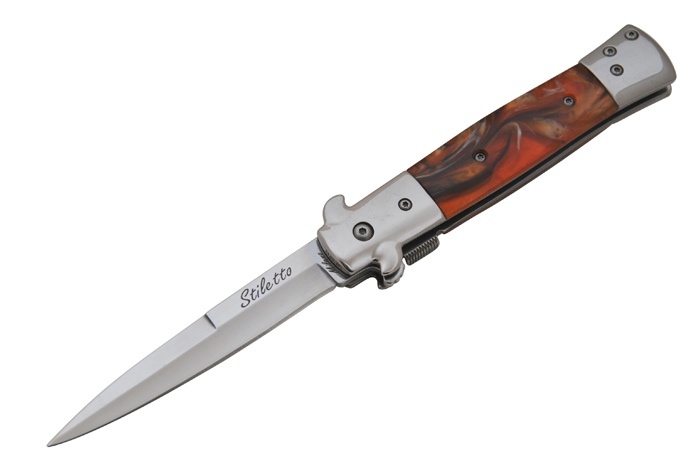 |
Know your local and state laws and regulations. Many
states ban knives that are automatic or spring assisted. Some locales
also have restrictions on blade length. If you are going to carry a
knife familiarize yourself with these regulations, make sure you are in
compliance. It is up to you to know the law and comply with the law.
Many police officers and civilians state that it is illegal to carry a
knife with a blade length longer than the width of their palm. This is
NOT a law in ANY locale, for the very obvious reason that every personís
palm is a different width. The statutes will state an exact length.
A knife is a piece of sharpened, worked metal usually with a handle. A fighting
knife will often also have guards to protect the hand. In most of the
world today knives are socially acceptable and in very common use, as a
knife is one of the most practical and versatile tools. But In order for
a tool to be an effective self-defense weapon it must become a part of
the individual. A knife serves well as both a primary self-defense tool
and as a back up to a firearm. |
A dagger possesses a double-sided blade and is primarily used for
thrusting with less dependence on a cutting edge. A dirk is basically
the same but possesses a small, circle or oval guard above the hand,
where as daggers have a more pronounced guard (such as a "T" shaped
guard). A knife is single edged and used for cutting and slashing. A
sword is essentially a larger version of any of the above.
Knife Fighting
Knives are contact weapons. You must be able to touch the person with
the knife in order to effectively utilize the knife. This means you
will be defending yourself at absolute contact distance, but this is
where many self-defense situations occur. Forget about throwing a
knife.
A good sharp knife can be absolutely devastating as a weapon. Insert
the knife into flesh in a point first stab and withdraw using a slashing
motion and the result will be a very large wound. The use of a knife is
very intuitive. Stab or slash with a knife; that is pretty much the
basics of knife fighting.
For a folding knife a good locking system or mechanism is vital. This
will keep the knife from closing on your fingers if used for
self-defense. One advantage of a fixed blade knife is that it will not
close on your hand. Practice opening and closing the folding knife blade with one hand.
This is critical in a knife used for self-defense. You should be able
to draw the knife, open and close it with one hand. This practice can
be done almost anywhere. This allows you to keep one hand free for
defending yourself while the other hand manipulates the knife. This
skill also becomes very convenient for daily use of the knife.
Grab a folding knife and keep it closed. By holding it in your closed
fist you have a usable, improvised Yawara stick. This is a less lethal
weapon. Use the bottom portion of your hand in a hammer strike with a
portion of the handle/case of the knife exposed to any of the bodyís
various nerve centers or pressure points. With just a flick of your
wrist or thumb to open the blade you now transformed your knife from a
less lethal weapon to a lethal weapon.
Although it does not affect the functionality of a knife at all a satin
or stainless steel blade may have some added psychological benefit. The
glint of a streetlight on a stainless steel blade may be all that is
needed to send a bad guy running should you have to draw your knife in a
self-defense situation.
Knife vs Gun
A knife can be used in situations where the use of a firearm isnít
prudent, in a crowd for instance where over-penetration and innocent
bystanders may be a concern. A missed shot with a firearm may result in
a bullet striking an innocent bystander. Likewise a bullet may
penetrate through the bad guy and hit a bystander. While disarming
someone who has a gun is no simple matter; disarming someone with a
knife generally involves grabbing a sharp piece of metal and is
infinitely more difficult. Not many people, even those who are highly
trained, are willing to attempt a knife disarm.
A knife does not need to be reloaded and short of breaking the blade or
catastrophic failure of the locking mechanism a knife does not
malfunction. A knife can defeat soft body armor.
While a bullet will shatter bone, a knife in the hands of an average
person will be stopped by bone. Likewise heavy clothing may minimize
the effectiveness of a knife, while heavy clothing does not drastically
affect the ability of a bullet to perform effectively. |
|